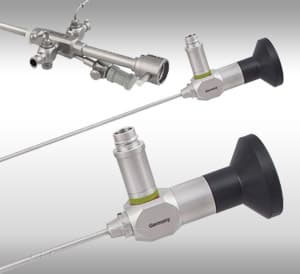
At VUBU, medical endoscopes stand for the highest quality and innovative technology. All our endoscopes are exclusively manufactured in Germany and meet the strictest quality standards. We place great emphasis on compatibility, ensuring that our products seamlessly integrate with most well-known manufacturers and systems. Whether for diagnostics or surgical procedures, our endoscopes are designed for professional use in the operating room and impress with their durability and precision.
Our Portfolio at a Glance
We offer rigid endoscopes with diameters ranging from 2.7 mm to 10 mm and usable working lengths from 50 mm to 480 mm. This variety allows us to provide the right instrument for almost every medical requirement. In addition, we offer a comprehensive range of endoscopic accessories, including:
Light guide cables in standard versions,
LED high-performance light guide cables for use with modern LED light sources,
Adapters for connecting to the most common light sources and endoscopes.
All our products are "Made in Germany" and comply with the highest international standards. You benefit from top-notch craftsmanship, reliability, and durability.
Repair Exchange and Buyback
We not only offer high-quality new products but also attractive solutions for repair exchanges or the purchase of your used medical endoscope. We are happy to provide you with a customized offer and assist you in choosing the best solution.
Online Catalog for Download
Our entire portfolio of medical endoscopes and endoscopic accessories can be found in our comprehensive online PDF catalog. Download the catalog here and explore our product range:
Contact and Consultation
Do you have questions or need personal advice? Our team is here to help. Call us at 07462-944486 or email us at info@vubu-medical.de. We look forward to assisting you in selecting the right instruments and finding the optimal solution for your requirements.
Rigid Endoscopes for Arthroscopy, Hysteroscopy, and Laparoscopy
We currently offer rigid endoscopes with diameters ranging from 2.7 mm to 10 mm and usable working lengths from 50 mm to 480 mm. Our endoscopes are available in various gradations (degree angles) and optics, including:
Forward-viewing optics,
Side-viewing optics,
Wide-angle optics,
Straight-viewing optics.
Additionally, we offer combinations of these optics to meet the specific needs of our customers. All endoscopes are autoclavable and feature an integrated fiberglass light guide. Thanks to the robust sapphire glass, they are highly resistant and scratch-proof. The standard shaft locking mechanism is compatible with Storz systems, making integration into existing operating environments seamless.
Standard Cold Light Cables – Flexible and Cost-Effective
Our standard light guide cables are ideal for use with halogen light sources. They provide reliable light transmission and are a cost-effective solution for many applications. Please note that these cables are less suitable for use with high-energy xenon light sources.
LED High-Performance Cold Light Cables
Our LED high-performance cold light cables are specifically designed for use with modern LED light sources. They enable significantly increased light transmission, which positively impacts the light output of HD optics and ensures optimal illumination of the surgical field.
Adapter Systems for All Cold Light Cables
Each cold light cable requires two adapters: one for the projector side (light entry side) and one for the endoscope connection (light exit side). We carry adapters for all common systems, including:
RfQ / Storz / Wisap / Aesculap / ACM / British
Welch Allyn / Stryker / Wolf / HSW / Dyonics
Medicon / Winter & Ibe / Heine Optotechnik
Schott / Zeiss (Colposcope) / Zeiss (Surgical Microscope)
Olympus / Olpi / FOT / Schölly / Fuji / Pentax
Endoscopes: Rigid and Flexible Variants
Endoscopes include both rigid and flexible models and their subtypes. Rigid endoscopes are often referred to by manufacturer-specific names such as borescopes, technoscopes, autoscopes, or intrascopes. Flexible fiber-optic endoscopes are also known as fiberscopes or flexoscopes.
Rigid endoscopes: Available in diameters from 1.6 mm to 19 mm.
Semi-rigid endoscopes: Available from 1.0 mm.
Flexible endoscopes: Ranging from 0.3 mm to 15 mm.
Video endoscopes: Ranging from 3.8 mm to 12 mm.
Rigid Medical Endoscopes at VUBU-MEDICAL
A rigid endoscope (also known as a rigid borescope) transmits image information from the object or cavity being examined through a lens system inside the endoscope shaft to the eyepiece. Examples include technical borescopes as well as medical endoscopes such as arthroscopes and cystoscopes.
A widely used system is the Hopkins rod-lens system, developed by Harold H. Hopkins, in which light is transmitted through rod lenses made of quartz glass and refracted at air lenses between the rods. This design allows for high light intensity and smaller lens diameters.
Most modern endoscopes feature a focusing ring near the eyepiece, allowing the image to be adjusted for optimal sharpness, even for eyeglass wearers. The necessary light is transmitted via an attached light guide through fiber-optic bundles to the tip of the endoscope.
The price of a rigid endoscope depends on the quality of the lenses used, the viewing angles of the objective, and the working length or diameter. Typically, prices are in the lower four-figure euro range.
Rigid endoscopes with an objective-side reflecting swivel prism allow for lateral viewing of cavities. By rotating the endoscope along its main axis and adjusting the prism, a larger solid angle can be scanned. A similar function is provided by a small polished metal mirror connected to the endoscope objective head via a flexible wire and sleeve.